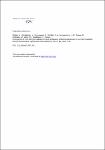Emergence of OXA-48-type carbapenemase-producing Enterobacteriaceae in German hospitals
Pfeifer, Yvonne
Schlatterer, Kathrin
Engelmann, Elisabeth
Schiller, Reinhold A.
Frangenberg, Hans Reiner
Stiewe, Doris
Holfelder, Martin
Witte, Wolfgang
Nordmann, Patrice
Poirel, Laurent
Nine carbapenem-resistant Enterobacteriaceae isolates collected from eight patients in five German hospitals were investigated. Six isolates produced the OXA-48 carbapenemase, and three isolates produced OXA-162, which is a point mutant form of OXA-48. Both carbapenemase genes were located on IncL/M-type conjugative plasmids. Insertion sequence IS1999 (truncated or not by IS1R) was located upstream of the bla(OXA-48) and bla(OXA-162) genes in all of the isolates. Pulsed-field gel electrophoresis typing indicated the clonal transmission of an OXA-48-producing Klebsiella pneumoniae strain in two hospitals.
Dateien zu dieser Publikation
Keine Lizenzangabe
Verwandte Publikationen
Anzeige der Publikationen mit ähnlichem Titel, Autor, Urheber und Thema.
-
2014-12-04ZeitschriftenartikelLow Rates of Antimicrobial-Resistant Enterobacteriaceae in Wildlife in Taï National Park, Côte d’Ivoire, Surrounded by Villages with High Prevalence of Multiresistant ESBL-Producing Escherichia coli in People and Domestic Animals Albrechtova, Katerina; Papousek, Ivo; Nys, Helene de; Pauly, Maude; Anoh, Etile; Mossoun, Arsene; Dolejska, Monika; Masarikova, Martina; Metzger, Sonya; Couacy-Hymann, Emmanuel; Akoua-Koffi, Chantal; Wittig, Roman M.; Klimes, Jiri; Cizek, Alois; Leendertz, Fabian; Literak, IvanAntimicrobial resistance genes can be found in all ecosystems, including those where antibiotic selective pressure has never been exerted. We investigated resistance genes in a collection of faecal samples of wildlife ...
-
2010-11-18ZeitschriftenartikelCarbapenem-non-susceptible Enterobacteriaceae in Europe: conclusions from a meeting of national experts Grundmann, Hajo; Livermore, D. M.; Giske, C. G.; Canton, R.; Rossolini, G. M.; Campos, J.; Vatopoulos, A.; Gniadkowski, M.; Toth, A.; Pfeifer, Yvonne; Jarlier, V.; Carmeli, Y.The emergence and global spread of carbapenemase-producing Enterobacteriaceae is of great concern to health services worldwide. These bacteria are often resistant to all beta-lactam antibiotics and frequently co-resistant ...
-
2010-10-21ZeitschriftenartikelHigh-throughput microarray technology in diagnostics of enterobacteria based on genome-wide probe selection and regression analysis Friedrich, Torben; Rahmann, Sven; Weigel, Wilfried; Rabsch, Wolfgang; Fruth, Angelika; Ron, Eliora; Gunzer, Florian; Dandekar, Thomas; Hacker, Jörg; Müller, Tobias; Dobrindt, UlrichBackground: The Enterobacteriaceae comprise a large number of clinically relevant species with several individual subspecies. Overlapping virulence-associated gene pools and the high overall genome plasticity often ...

